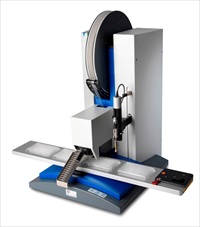Members Login

Channels
Special Offers & Promotions
Major Protein Structure Discovery Achieved Using TTP Labtech
Major Protein Structure Discovery Achieved Using TTP Labtech’s mosquito LCP Innovative liquid handling technology a key factor in the world’s first structural analysis of class B GPCRs
 For the first time, researchers have been able to successfully report the structure of a Class B G-Protein Coupled Receptor (GPCR) using lipidic cubic phase (LCP) protein crystallisation. The work performed at Heptares, a leading drug discovery and development company, and published this week in Nature, details the structural identification of the stress receptor, corticotropin-releasing factor receptor 1 (CRF1). This pioneering discovery opens up the technique to an entirely new group of molecules with important roles in the development of diseases as diverse as diabetes, osteoporosis, depression and anxiety. The mosquito LCP, an innovative solution for LCP crystallography designed by TTP Labtech, was a significant technical driving force enabling the research and underlines the company’s role in facilitating cutting-edge drug discovery research.
For the first time, researchers have been able to successfully report the structure of a Class B G-Protein Coupled Receptor (GPCR) using lipidic cubic phase (LCP) protein crystallisation. The work performed at Heptares, a leading drug discovery and development company, and published this week in Nature, details the structural identification of the stress receptor, corticotropin-releasing factor receptor 1 (CRF1). This pioneering discovery opens up the technique to an entirely new group of molecules with important roles in the development of diseases as diverse as diabetes, osteoporosis, depression and anxiety. The mosquito LCP, an innovative solution for LCP crystallography designed by TTP Labtech, was a significant technical driving force enabling the research and underlines the company’s role in facilitating cutting-edge drug discovery research.
GPCRs are valuable drug targets. GPCRs are a family of proteins that play an essential part in cell signalling and are thus important drug targets for modulating cell function and influencing disease outcome. The Class B subset of GPCRs includes many peptide hormone receptors relevant for treating disease, such as glucagon, glucagon-like peptide, calcitonin and parathyroid peptide hormone. However, until the recent work carried out by Heptares, it had proven almost impossible to provide structural data for this class, severely hampering drug development efforts across the industry.
The finding that the structure of CRF1, a Class B GPCR, contains a novel binding pocket for the small molecule antagonist, towards the intracellular side of the receptor and far from the position of other Class A GPCR ligands, underlines the importance of the discovery; particularly in terms of modelling other Class B receptors and potentially unlocking drug design across the subset.
Structural biology directs rational drug discovery. Generating crystalline structures of key biological receptors is an important step in drug discovery, as it enables protein-protein interactions to be reliably predicted and fuels the rational design of molecules engineered to influence receptor activity. However, protein crystallography, often referred to as the ‘black art’, is frequently a long and complex process requiring great technical skill, precision and patience. This is especially true when working with complex transmembrane structures such as GPCRs, which require the optimisation of specific experimental and environmental conditions for each discrete structure.
To help increase the accuracy, speed and throughput of crystallography screening and production, expert developers such as TTP Labtech have engineered innovative automated liquid handling solutions, including the mosquito crystal and mosquito LCP, to significantly improve this process.
Dr. Andrew S. Doré, Head of Crystallography at Heptares Therapeutics Ltd and co-author of the recent article in Nature, said: “In any crystallographicproject, eliminating variables is key in producing a steady stream of crystallisation grade protein for structure determination efforts. This of course also extends to crystallisation itself.” He continued: “We had to stitch together data from 35 isomorphous crystals to produce a full dataset for the CRF1 structure solution. Mosquito LCP provided a reliable platform for our CRF1 LCP crystallisation, deploying reproducible low volume boli at speed, and ultimately yielding a large sample set of CRF1 crystals for subsequent diffraction analysis.”
TTP Labtech's mosquito LCP is used by most of the world class institutions and leading pharmaceutical and biotechnology companies for protein crystallisation screening and production, playing an important role in the identification of many protein structures, including important GPCRs. However, this is perhaps the most significant, high profile discovery published to date using the technology.
"We've worked closely with Dr Doré's team at Heptares since 2010 - in fact hey were one of the earliest adopters of the mosquito LCP,” said Joby Jenkins, Global Director of Automation at TTP Labtech. "Heptares has now solved in excess of 35 GPCR structures to date - no mean feat when working with such a complex experimental process. We are delighted to have the opportunity to work with such a talented team and look forward to the new GPCR discoveries in the future.”
more about Class B G-Protein Coupled Receptor (GPCR)
About TTP Labtech
From its global headquarters based near Cambridge, UK, TTP Labtech creates, designs and manufactures robust, reliable and easy-to-use instrumentation to offer life scientists better tools and techniques, simplifying complex operations, saving time and material costs.
TTP Labtech provide state-of-the-art solutions developed for specific product areas including: cell-based screening (acumen®, mirrorball®); sample management (comPOUND®, arktic®), low volume liquid handling (mosquito®, dragonfly®) and the management of analytical automation (lab2lab). TTP Labtech is owned by its employees, and our continued drive to innovate combines cutting edge science with first rate engineering, manufacturing and outstanding customer support.
About Heptares
Heptares creates new medicines targeting previously undruggable or challenging GPCRs, a superfamily of receptors linked to many diseases. It is pioneering a structure-based drug design approach to GPCRs, leveraging proprietary technologies for protein stabilisation, structure determination, and fragment-based discovery. Its partners include Shire, Cubist, Takeda, MorphoSys, AstraZeneca and MedImmune. Its objective is to build a broad pipeline of novel medicines to transform the treatment of serious diseases, including Alzheimer’s disease, Parkinson’s disease, schizophrenia, depression, chronic insomnia, addiction, migraine and diabetes.
Media Partners


